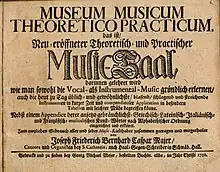
Joseph Friedrich Bernhard Caspar Majer (Schwäbisch Hall, 16 October 1689 - Schwäbisch Hall, 22 May 1768), was a German musician from the beginning of the 18th century, a "significant writer" on music in the late Baroque era.[1]
He was a singer at Schwäbisch Hall, an organist and cantor at St. Katharina, and author of two books, music methods:
- 1718, Hodegus musicus. Teaches singing. A later edition published Schwäbisch Hall by Georg M. Majer, 1741.[2]
- 1732, Museum musicum theoreticalo-practicum. The author advertised on the title page that readers would learn how to thoroughly learn both vocal and instrumental music) (1732).[3] A second edition came out in 1741.[3]
His second book was written to acquaint would-be musicians with information to help them learn to play instruments. The instruments included: recorder, chalumeau, transverse flute, 3-keyed bassoon, cornett, flageolet, and 2-keyed clarinet, clarion trumpet, tenor and bass trombone, alto and quint trombone, horn, lute, "harp" or psaltery, guitar, timpani, violin, viola, cello, viola de gamba and viola d'amore.[3] The book also includes the basics for reading music, a "survey of vocal music and intervals," and a dictionary of musical terms. [3][4]
What made him to be considered a significant writer was the annotations that he made in his personal copy of Museum musicum theoreticalo-practicum.[1] That city reside in the Wiirttembergische Landesbibliothek, Stuttgart.[3]
 Tenor Bass Recorder
Tenor Bass Recorder Chalumeau
Chalumeau Transverse flute
Transverse flute Bassoon
Bassoon Flageolet
Flageolet Two-key clarinet
Two-key clarinet Clarion
Clarion Fingering chart, cornett
Fingering chart, cornett Tuning the lute, fretboard
Tuning the lute, fretboard Lute, strings, their notes placed
Lute, strings, their notes placed Psaltery
Psaltery
References
- 1 2 Buelowm, George J. (2001). "Majer, Joseph Friedrich Bernhard Caspar". Grove Music Online. doi:10.1093/gmo/9781561592630.article.17499.
- ↑ "Major Joseph Friedrich Bernhard Caspar 1689-1768".
Hodegus musicus oder getreu-musikalischer Wegweiser, darinnen gezeiget wird das rechte Fundament der Singkunst (translation: Hodegus musicus or faithfully musical signpost, showing the right foundation of the art of singing) ...1 copy preserved...Utrecht, Bibliothek der Rijksuniv
- 1 2 3 4 5 Poulin, Pamela L. (November 1991). "Review: Joseph Friedrich Bernhard Caspar Majers Neu-eröffneter Theoretisch- und Praktischer Music-Saal (Nuremberg, 1741) by Eitelfriedrich Thom". Music & Letters. 72 (4): 587–589. doi:10.1093/ml/72.4.587. JSTOR 737015.
- ↑ "PRINTED SOURCES OF MUSIC for LUTE, ORPHARION, BANDORA, VIHUELA, ARCHLUTE, CHITARRONE AND THEORBO". Retrieved 15 February 2023.
1732 Majer, Joseph Friedrich Bernhard Caspar, Museum musicum theoretico practicum, das ist: Neu-eröffneter theoretisch- und practischer Music-Saal...treatise with tuning chart for the 11-course lute in French tablature
- Maier, Joseph F. (1732). Museum Musicum Theoretico-Practicum. München, Bayerische Staatsbibliothek. Schwäbisch Hall.